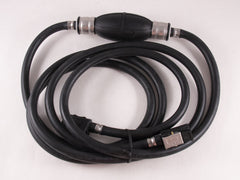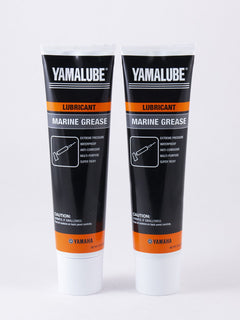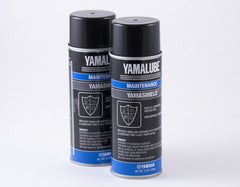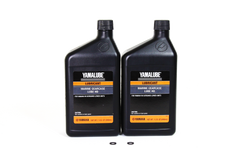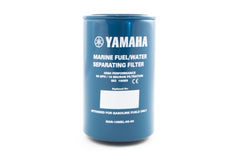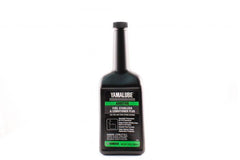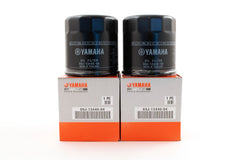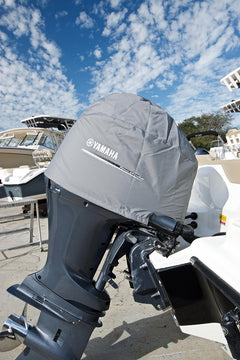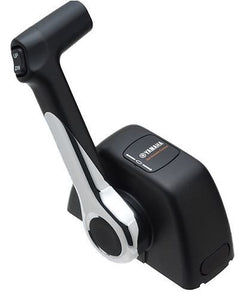Yamaha Outboard Gauges - Overview & Selection Guide
How's Your Engine Performing
If you’re a boating enthusiast who’s passionate about having the ultimate experience each time you hit the water, it’s essential to have a reliable marine gauge that will provide you with the information you need. The good news is that Yamaha offers plenty of options to choose from. No matter what type of boating experience you envision for yourself, you’ll be able to find a gauge that’ll meet all of your needs.
Here at Yamaha Online Parts, we proudly carry a wide range of Yamaha marine gauges at Yamaha Online Parts. Whether you prefer digital or analog, need a replacement or an upgrade, or just learn more to learn more about your engine, this guide is for you.
In this guide, we’ll cover the following topics in detail for Yamaha Outboard Gauges:
- Types and Styles of Yamaha Gauges
- Yamaha Digital Gauges vs. Yamaha Analog Gauges - What’s Better for My Yamaha Outboard Motor?
- Yamaha Outboard Gauge Kits
- Are Aftermarket Yamaha Outboard Gauges Worth Purchasing?
- Schematics for Yamaha Outboard Gauge
- Yamaha Outboard Gauges: Tips for Resale Value
- Yamaha Outboard Gauges FAQ
- Purchase Yamaha Outboard Controls and Gauges with Yamaha Online Parts
Types and Styles of Yamaha Gauges
Types and Styles of Yamaha Gauges
Yamaha offers a range of outboard gauges to help you monitor and manage the performance of your outboard.
Types of Yamaha Outboard Gauges
Yamaha produces a variety of gauges for their outboard motors, including:
|
Type of Gauge |
What It Does |
|
Referred to as a “Yamaha tach,” this gauge displays the engine RPM and helps monitor the engine performance and load. |
|
|
This gauge displays the boat's speed in either mph or km/h. |
|
|
Shows the fuel level and consumption, helping you monitor fuel usage and avoid running out of fuel on the water. |
|
|
A Yamaha trim gauge displays the position of the outboard motor's trim and tilt, allowing you to optimize the boat's performance and handling. |
|
|
This gauge displays the voltage of the boat's battery and electrical system, helping you monitor the battery's charge and prevent it from discharging. |
|
|
This gauge displays the water pressure and enables you to monitor the cooling system performance, ensuring that the engine stays within its optimal operating temperature range. |
These are some of the most common gauges Yamaha produces for their outboard motors. The exact types and models of gauges available for your specific outboard motor can vary, so it's best to consult your owner's manual or a Yamaha dealer for more information.
Styles and Features of Yamaha Outboard Gauges
Here is an overview of the outboard gauges Yamaha currently offers by styles and features:
|
Style of Gauge |
Features of Gauge |
|
These gauges provide an advanced digital display of key engine parameters including RPM, fuel level, and engine trim. They offer convenient and accurate monitoring and are suitable for use in various boat types and applications. |
|
|
These gauges feature a traditional mechanical dial and pointer display of key engine parameters, including RPM and engine trim. They provide a simple and reliable monitoring option and are suitable for various boat types and applications. |
|
|
These gauges integrate with the Yamaha Command Link system and provide an advanced digital display of key engine parameters, including RPM, fuel level, and engine trim. They offer convenient and advanced monitoring and are suitable for various boat types and applications. |
|
|
These gauges are designed to match the style and design of your boat and are available in multiple finishes and colors. They offer customized and personalized look and feel to your instrumentation. |
By selecting the proper gauges for your Yamaha outboard, you can monitor and manage the performance of your outboard with ease and confidence.
Yamaha Digital Gauges vs Yamaha Analog Gauges - What's Better for My Yamaha Outboard Motor?
Yamaha Digital Gauges vs Yamaha Analog Gauges - What’s Better for My Yamaha Outboard Motor?
Both digital and analog gauges have advantages and disadvantages, so it ultimately depends on your preferences and specific needs.
Making the Decision to Go Digital or Stay Analog
Analog Gauges
Analog gauges are traditional gauges that use mechanical mechanisms to display readings. They have been used for decades and are reliable and easy to read. They are also generally less expensive than digital gauges. However, they may not provide as accurate readings as digital gauges, and they can be more difficult to read in certain lighting conditions.
Digital Gauges
Digital gauges, on the other hand, use electronic displays to provide more accurate and precise readings. Digital boat gauges can also offer a wider range of information, such as fuel efficiency and diagnostic codes. They are also typically easier to read in various lighting conditions, and some models can be customized to display information in different languages. However, they are usually more expensive than analog gauges and require a power source, which means they can drain your battery.
Yamaha Smart Gauges
Yamaha smart gauges are digital gauges that provide advanced and accurate information about Yamaha outboard motors. They typically include a multifunction digital display showing engine RPM, speed, fuel level, oil pressure, water temperature, battery voltage, and trim angle. Some models include GPS navigation, weather data, and fuel consumption information.
Yamaha smart gauges communicate with the outboard motor's onboard computer system for more accurate and detailed real-time information. They have buttons and controls to adjust settings like backlighting, alarm thresholds, and display layout, and some models offer Bluetooth or Wi-Fi connectivity for mobile devices and other compatible systems. Yamaha smart gauges are a powerful tool that helps boaters make informed decisions, improve overall efficiency and safety, and offer advanced features for convenience and functionality.
What’s the best choice for me?
In general, if you prioritize accuracy and want more information than just basic readings, digital gauges may be a better choice - with smart gauges being Yamaha’s most advanced options at a higher price tag.
If you prefer a more traditional and straightforward approach (and want to save money), analog gauges may be better.
Ultimately, the best choice will depend on your specific needs, preferences, and what you feel most comfortable with.
Popular Yamaha Analog Outboard Gauges
Looking for classic simplicity with your Yamaha marine gauge?
If so, you’ll love the analog gauges from Yamaha Online Parts. Some excellent options you should consider include the Pro Series II™ and Pro Series™ analog models. These Yamaha outboard gauges offer simplicity while providing the vital information you need. The Pro Series II is available in illuminated black or white faceplate designs for the speedometer, tachometer, fuel level meter, and more. Alternatively, the Pro Series comes in an illuminated black-and-orange faceplate.
Popular Yamaha Digital Outboard Gauges
For those who are fans of technology and want all the information they can get, you’ll love digital gauges like the Command Link Plus. This Yamaha outboard gauge features a 5-inch high-resolution LCD. This complete system is compatible with new Yamaha engines. It includes the displays, engine throttle shift, start-stop, and more. You’ll enjoy the ability to display the data for up to three outboards.
You should also check out the Yamaha 6YC Information Station, which can be used with the Command Link Plus and up to two Yamaha outboard motors. You’ll be saving console space while also having access to even more information in a more straightforward format that’s easy to understand. These noteworthy features include a color display, a compact size of 6.5 inches, and a non-glare flat back surface. You’ll even be able to track engine RPM, fuel levels, fuel economy, and much more. This is the way to go when you need a multi-function outboard gauge setup.
Yamaha Outboard Gauge Kits
Yamaha Outboard Gauge Kits
A Yamaha gauge kit from Yamaha Online Parts comes with everything you need to easily install a new gauge for your boat and Yamaha outboard engine.
As an example, the Yamaha Command Link Single Engine Gauge Kit, with Tachometer and Forward & Aft Multi-Hub Assemblies, includes all of the wiring and parts needed to be successfully installed with any Yamaha F30 - F350 produced after 2006 and is used in a single engine application. The following parts are included:
-
Tachometer Assembly
-
Multi-Hub Assembly (2 ea)
-
Power Lead, 8ft.
-
Cap, 2 Pin
-
Cap, 4 Pin (4 ea)
-
Pigtail Harness, Engine to Rear Hub, 9ft.
-
User Operation Guide
Installing New Yamaha Outboard Gauges with a Yamaha Gauge Kit
Installing new Yamaha outboard gauges with a Yamaha gauge kit can be done in a few simple steps. Here's a general guide on how to do it:
-
Gather the necessary tools and materials. You will need a screwdriver, pliers, wire strippers, electrical tape, and the Yamaha gauge kit.
-
Turn off the battery switch and disconnect the negative battery cable to avoid electrical shock or damage to the gauges.
-
Remove the old gauges from the dashboard by unscrewing the mounting screws and disconnecting the wiring harnesses.
-
Install the new gauges from the Yamaha gauge kit by mounting them onto the dashboard using the provided screws. Make sure the gauges are level and securely fastened.
-
Connect the wiring harnesses from the new gauges to the corresponding wires on the boat's electrical system. Refer to the installation instructions for specific wiring connections.
-
Test the gauges to make sure they are working correctly. Turn on the battery switch and start the engine. Check each gauge for accurate readings.
-
Once satisfied with the installation, tidy up the wiring by securing any loose wires with electrical tape and securing the wiring harnesses to the boat's frame using zip ties.
-
Turn off the engine and disconnect the negative battery cable before reinstalling any dashboard covers or panels.
-
Finally, turn on the battery switch and start the engine again to verify that the gauges are functioning correctly.
It's important to follow the instructions with the Yamaha gauge kit, as the exact installation process may vary depending on the specific kit and the outboard motor used. If you are uncomfortable performing the installation yourself, it's best to have a professional install the gauges.
Are Aftermarket Yamaha Outboard Gauges Worth Purchasing?
Are Aftermarket Yamaha Outboard Gauges Worth Purchasing?
The truth is that you pay for what you get regarding the quality of your boating experience.
Aftermarket gauges may be a good option if you're only looking for a cost-effective solution. They tend to be less expensive than OEM gauges and often offer similar functionality. Additionally, aftermarket gauges may be easier to find and replace if malfunctioning.
However, if you're concerned about compatibility, it may be best to use OEM gauges. Yamaha OEM gauges are designed to work specifically with Yamaha outboards and are guaranteed to be compatible with your engine. Additionally, adding an aftermarket gauge may require additional wiring and components if you're already using Yamaha OEM gauges. Last, if a mechanical issue occurs due to a faulty aftermarket gauge, you may not be covered by Yamaha’s limited warranty (or extended warranty service).
Schematics for Yamaha Outboard Gauge
Schematics for Yamaha Outboard Gauge
To ensure that you have a handy reference to perform repairs AND order the exact parts you need, you’ll need Yamaha Outboard Gauge Schematics. Refer to this online Yamaha Engine Schematic database (powered by Snap-On Electronics Parts Catalog / Snap-On EPC) to help you find the right parts number to order on Yamaha Online Parts.
Once you’ve navigated to the database, you’ll only have to make a few clicks to match your particular model of outboard and needs:
-
Start by clicking on Rigging Parts & Propellers
-
The next screen will offer three options:
-
Rigging & Parts for 2005 Models and Older
-
Rigging & Parts for 2006 Models and Later
-
Rigging & Parts 2014 and Later
-
-
Once you’ve matched your outboard’s year, you’ll be presented with several options regarding Outboard Gauges and other rigging options. Select your matching gauge from the available options.
-
In the next screen, you’ll be presented with a list of schematics. Click on the appropriate schematic.
-
Note: Be sure to match your identical gauge model, as there are many similar options.
-
-
Once you’ve selected the schematic, you’ll have a visual reference indicating all of the gauge’s parts and components with numbers corresponding to the part number.
-
Using the number, click the matching part on the schematic OR click the corresponding number on the parts list (which will highlight the parts on the schematic for verification).
-
Next to each list of each part is a shopping cart icon. Clicking on the icon will add the part to a Shopping Cart list at the bottom of the screen (on desktop). Continue this process to populate the list with everything you need.
-
The list organizes each part into categories:
-
OEM
-
Model
-
Part Number
-
Qty (Quantity)
-
Description
-
Cover
-
Retail (Pricing)
-
-
You'll find three icons on the left side of the list:
-
Clear Shopping Cart
-
Print Shopping Cart
-
Email Shopping Cart
-
Once you’ve printed or emailed your completed list of parts, you can enter the parts number into Yamaha Online Parts’ Search box, add the matching item(s) to your shopping cart, and finalize your purchase.
Yamaha Outboard Gauges: Tips for Resale Value
Yamaha Outboard Gauges: Tips for Resale Value
If you plan on selling your Yamaha outboard shortly, you may want to consider which types of gauges appeal to buyers. In general, several types of buyers look for qualities in a boat or outboard motor that influence their final decision-making:
-
If your boat or outboard motor is a classic model, having analog gauges gives it a more vintage appeal that makes the purchase appear more authentic (even if the older gauges are replaced with refurbished or older replacement parts in working condition).
-
If you have a newer model outboard, having the latest digital gauges and functionality is usually a crucial selling point for higher ticket prices when looking to upsell the resale value. Having the “latest and greatest” gauges means that the seller has taken the time to care for the boat and keep up with the latest tech innovations, communicating to buyers that the outboard was cared for.
-
Retrofitting an older model boat or outboard with newer digital Yamaha multi-function gauges can be a selling point; however, be prepared to answer any questions about compatibility and whether the boat is no longer completely original.
Yamaha Outboard Gauges FAQ
What are the most common problems with Yamaha outboard gauges?
Several common problems can occur with Yamaha outboard gauges. Here are a few:
- Gauge not working: One of the most common issues with outboard gauges is that they stop working. This can happen due to a faulty gauge, a loose connection, or a blown fuse. To troubleshoot the problem, check the connections and the fuse. If they are okay, it might be a faulty gauge that must be replaced.
- Inaccurate readings: Another common issue with outboard gauges is that they can give inaccurate readings. For example, the fuel gauge may show an incorrect level, or the speedometer may give a reading that is too high or too low. A faulty sensor, a loose connection, or a problem with the gauge itself can cause this.
- Erratic readings: Sometimes, outboard gauges can give erratic readings, jumping up and down or fluctuating rapidly. A faulty sensor, a loose connection, or a problem with the gauge can cause this.
- Backlight not working: The backlight on outboard gauges can also stop working, making reading difficult at night difficult. A blown bulb or a faulty connection can cause this.
- Tachometer not working: The tachometer on outboard gauges can also stop working, making it difficult to monitor engine speed. This can be caused by a faulty gauge or a problem with the wiring.
- Gauge glass fogging up: In some cases, the glass on outboard gauges can fog up, making it difficult to read the gauge. This can be caused by moisture entering the gauge or a faulty seal.
Which Yamaha gauges are compatible with older outboard motors?
- Yamaha 6Y5-2818R-32: This gauge is a multi-function tachometer that is compatible with Yamaha outboard motors that use a 4-stroke EFI or a 2-stroke HPDI engine.
- Yamaha 6Y5-8350T-83-00: This gauge is a digital speedometer that is compatible with Yamaha outboard motors that use a 4-stroke EFI engine.
- Yamaha 6Y5-8350F-01-00: This digital fuel management gauge is compatible with Yamaha outboard motors that use a 4-stroke EFI engine.
- Yamaha 6Y5-8350T-91: This gauge is a digital trim meter compatible with Yamaha outboard motors that use a 4-stroke EFI engine.
Is a Yamaha speedometer the same as a Yamaha tachometer?
Is it a good decision to buy used Yamaha outboard gauges or invest in new ones?
- Cost: One advantage of buying used gauges is that they are often cheaper than new ones. However, the cost savings may not be worth it if the gauges are outdated, unreliable, or in poor condition.
- Condition: When buying used gauges, it's important to carefully inspect them for signs of wear and tear, damage, or malfunction. The gauges may be a good choice if they are in good condition and well-maintained.
- Compatibility: It's important to ensure the used gauges are compatible with your outboard motor. If the gauges are incompatible, it may be more trouble than it's worth trying to make them work.
- Warranty: New gauges typically come with a warranty that can provide peace of mind and protection against defects or malfunctions. Used gauges may not come with a warranty, which could be risky if they fail soon after purchase.
- Features: New gauges often come with advanced features and technology that may not be available in older used gauges. It may be worth investing in new gauges if you are looking for specific features or functionality.
Can I monitor my Yamaha outboard's performance without relying on gauges?
- Listen to the engine: One of the easiest ways to monitor your outboard's performance is to listen to the engine. Changes in sound, such as rough idling, misfiring, or unusual noises, can indicate that something is not working properly.
- Check the water flow: If your outboard is not pumping water properly, it can cause the engine to overheat and suffer damage. You can check the water flow by looking for a steady stream of water coming out of the telltale hole on the outboard's lower unit. If the flow is weak or intermittent, it could indicate a blockage or other issue.
- Monitor fuel consumption: Keeping track of how much fuel your outboard is using can give you an idea of how well it's performing. If your fuel consumption has suddenly increased or decreased, it could be a sign of a problem with the engine or fuel system.
- Check the oil level: Checking the oil level regularly can help you detect any potential issues with the engine. If the oil level is low or if the oil is dirty or contaminated, it could be a sign of a problem.
- Use a mobile app or software: Several mobile apps and software are available that can help you monitor your outboard's performance, even without gauges. These apps, such as the MyYamahaOutboard App, can provide real-time data on fuel consumption, engine RPM, and other performance metrics and alert you to any issues or anomalies.
How do I protect my Yamaha outboard gauges with Yamaha gauge covers?
- Purchase Yamaha gauge covers designed to fit your specific gauges. Yamaha offers gauge covers that are custom-made for their outboard gauges.
- Clean your gauges thoroughly before installing the covers. Use a soft cloth and a mild soap solution to remove dirt or debris from the gauges. Make sure the gauges are completely dry before proceeding.
- Install the Yamaha gauge covers over the gauges. Most Yamaha gauge covers simply slip over the gauges and are secured with an elastic band or a Velcro closure. Follow the manufacturer's instructions for your specific covers.
- Adjust the covers as needed to ensure a snug fit. The covers should fit tightly cover the gauges to protect them from dirt, water, and UV rays.
- Periodically remove the covers and clean them as needed. The covers can be washed with a mild soap solution and air-dried before reinstalling.
- Inspect the gauges regularly to ensure they are functioning correctly Remove the covers and check for any signs of damage or wear on the gauges. If you notice any issues, have them repaired or replaced by a qualified technician.

